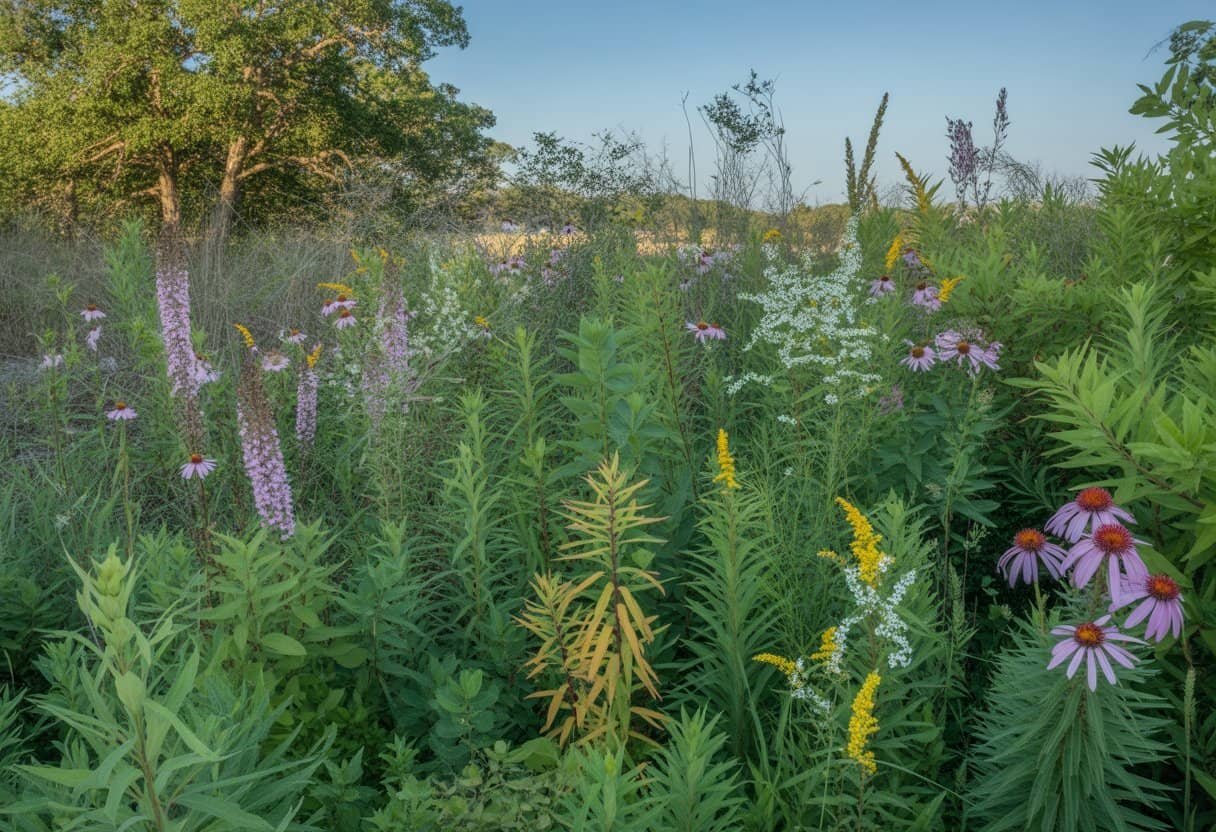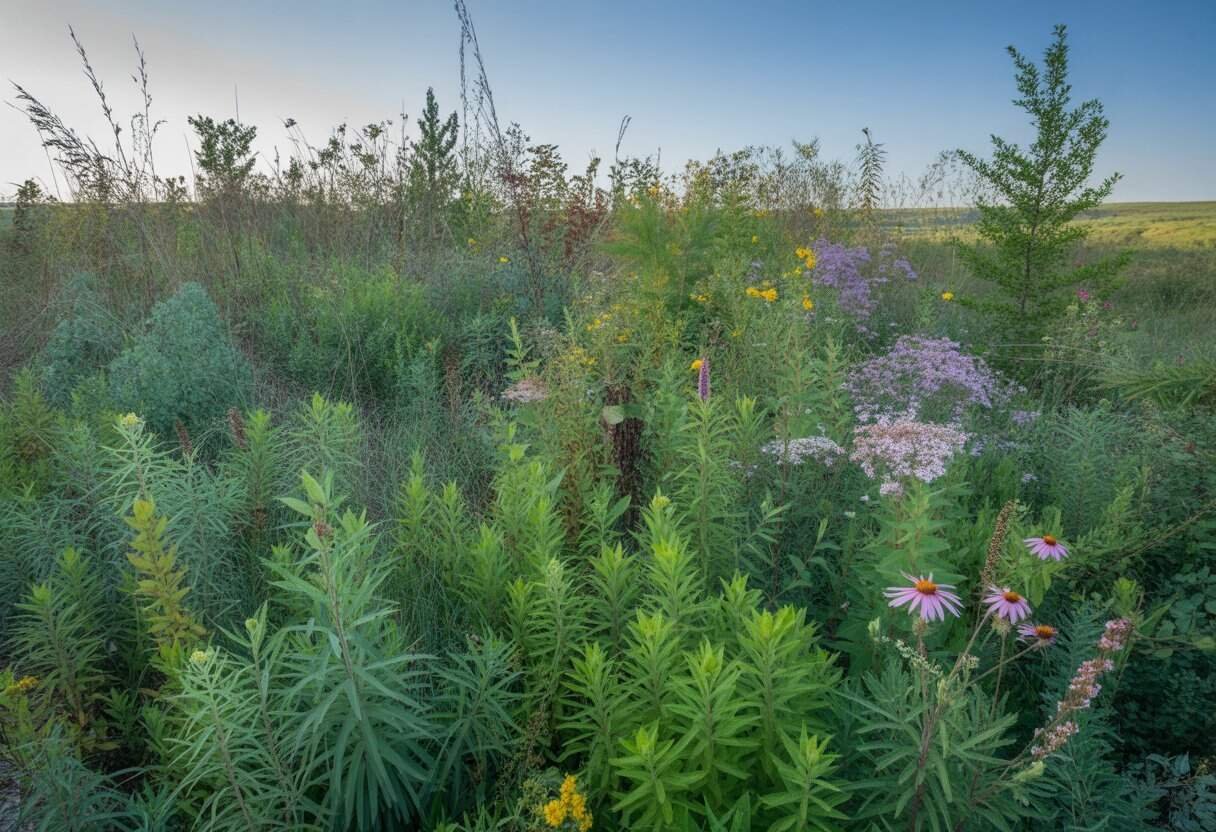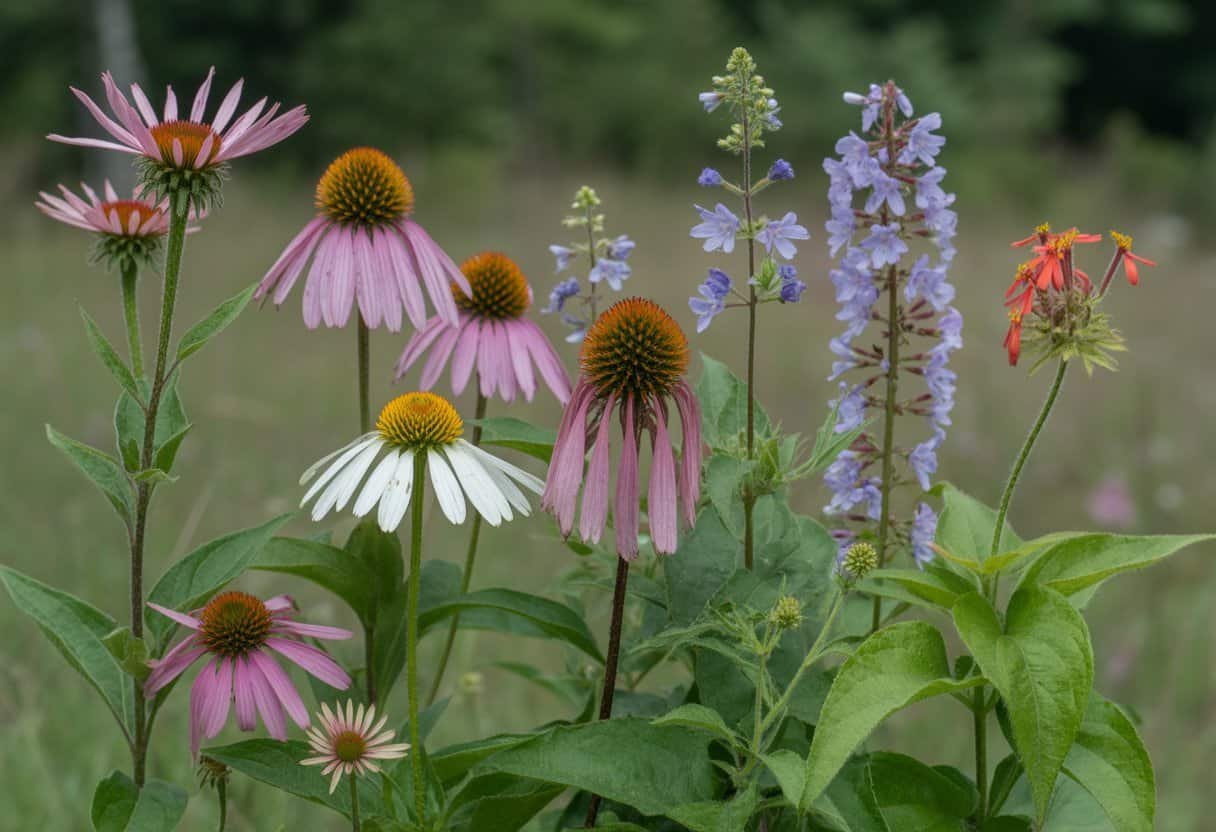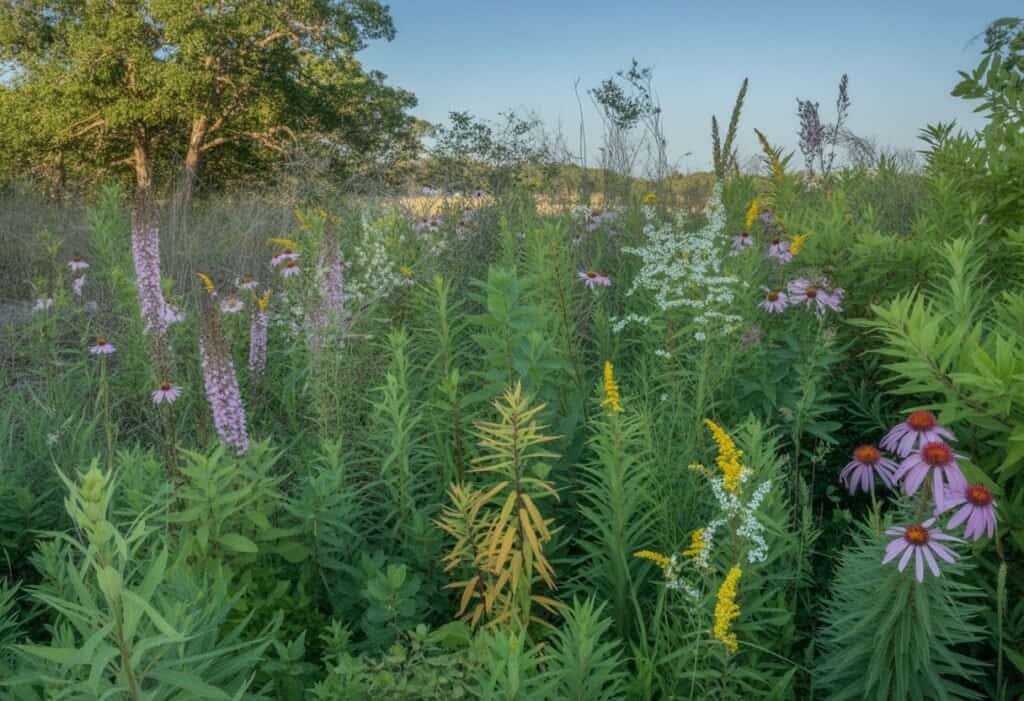Arkansas native plants bring beauty and function to our landscapes. These plants have evolved over thousands of years to thrive in our unique climate and soil conditions.
Native plants require less water, fertilizer, and maintenance than non-native species while providing essential habitat for local wildlife.

From the delicate beauty of wild hydrangeas to the sturdy resilience of prairie grasses, Arkansas boasts an impressive diversity of native flora. The Natural State’s varied topography creates distinct growing regions that support everything from woodland wildflowers to wetland species.
Incorporating these indigenous plants into your garden connects you to Arkansas’s natural heritage. They represent the botanical legacy that has shaped our state since long before statehood.
Key Takeaways
- Arkansas native plants require less maintenance while supporting local wildlife ecosystems.
- The state’s diverse landscapes support a wide variety of native plant species from woodland flowers to prairie grasses.
- Using native plants in landscapes preserves Arkansas’s natural heritage and promotes environmental conservation.
Understanding Arkansas Native Plants
Arkansas’s landscape is rich with diverse plant species that have evolved alongside the state’s unique climate and soil conditions. These native plants form the backbone of local ecosystems and provide many benefits to wildlife and people.
Definition and Characteristics
Native plants are species that have grown naturally in Arkansas for thousands of years, long before European settlement. These plants have adapted to local rainfall patterns, soil types, and temperature ranges.
Arkansas native plants include trees like the Flowering Dogwood and Shortleaf Pine. Shrubs such as the Arkansas Yucca and Rusty Blackhaw, and wildflowers like Purple Coneflower and Wild Bergamot, also thrive here.
These plants typically require less maintenance than non-native species. They generally need less water, fertilizer, and pest control once established.
Many Arkansas natives have developed specific traits to thrive in local conditions. Some have deep root systems to access groundwater during dry periods. Others have protective coatings to survive winter temperatures.
Ecological Importance
Native plants form the foundation of Arkansas’s diverse ecosystems. They provide essential food, shelter, and breeding grounds for local wildlife species.
Wildlife Benefits:
- Food sources (berries, seeds, nectar)
- Nesting materials and shelter
- Host plants for butterfly and moth larvae
Arkansas native plants support specialized relationships with local pollinators. Many native bees, butterflies, and moths can only reproduce using specific native plants as hosts for their young.
These plants also play crucial roles in soil health. Their extensive root systems prevent erosion, especially in riparian areas along the state’s waterways.
Native plant communities help filter water as it moves through the soil, improving water quality in streams, rivers, and lakes. They also sequester carbon, which helps mitigate climate change impacts.
Native vs. Non-Native Species
Native plants evolved in Arkansas’s ecosystems over thousands of years. Non-native plants arrived from other regions or countries.
Non-native plants often lack natural controls like specific insects or diseases that would limit their growth in their original habitats. Without these limitations, some become invasive and outcompete native species for resources.
Invasive plants like Bradford Pear, Japanese Honeysuckle, and Kudzu can quickly dominate natural areas. They reduce biodiversity by creating monocultures where diverse native plant communities once thrived.
Native plants support more wildlife species than non-natives. They’ve co-evolved with local insects, birds, and mammals, creating interdependent relationships.
Using Arkansas natives in landscaping preserves the state’s natural heritage and supports conservation. They connect fragmented habitats and provide corridors for wildlife movement across developed areas.
Native Plant Habitats in Arkansas

Arkansas offers diverse habitats that support a rich variety of native plants. The state’s unique geography creates different growing conditions across regions, from mountainous highlands to lowland swamps.
Natural Areas and Ecosystems
Arkansas contains six distinct natural divisions, each supporting unique plant communities. The Ozark Mountains feature limestone-based soils that nurture plants like wild hydrangea and serviceberry.
The Ouachita Mountains, with their east-west orientation, create unusual microclimates supporting rare species like the Ouachita bluet. The Arkansas River Valley serves as a transition zone where prairie and forest plants intermingle.
Native grasses like little bluestem thrive here alongside flowering perennials. The Gulf Coastal Plain in southern Arkansas features pine-dominated forests.
Longleaf pine once covered millions of acres here, supporting a diverse understory of plants. The Mississippi Alluvial Plain (Delta) contains rich bottomland hardwood forests with wet areas that support cypress trees, water tupelo, and numerous wetland species.
The Crowley’s Ridge ecosystem stands as a unique habitat island with plants more typical of eastern forests.
Soil Type and Sun Exposure
Arkansas soils vary dramatically across the state, directly influencing which native plants grow where. The acidic, sandy soils of the coastal plain support acid-loving plants like azaleas and blueberries.
The limestone-derived soils of northern Arkansas create alkaline conditions perfect for redbud trees and many prairie plants. Clay soils in central Arkansas retain moisture but can challenge root development.
Plants like ironweed and Joe-Pye weed have adapted to these conditions. Sun exposure creates additional microhabitats within each region.
South-facing slopes receive intense sunlight, supporting drought-tolerant species like black-eyed Susans and prairie coneflowers. North-facing slopes maintain more moisture and cooler temperatures.
These areas often host shade-loving plants like wild ginger and foam flower.
USDA Hardiness Zones
Arkansas spans USDA Hardiness Zones 6a through 8a, creating different plant survival conditions across the state. Northern Arkansas falls primarily in Zone 6, with minimum temperatures reaching -10°F.
This zone supports cold-hardy natives like pawpaw trees and wild plums. Central Arkansas generally falls within Zone 7, experiencing minimum temperatures between 0°F and 10°F.
This moderate zone supports a wide range of natives including beautyberry and sassafras. Southern Arkansas reaches into Zone 8, rarely experiencing temperatures below 10°F.
This milder climate allows for less cold-tolerant species like southern magnolia and American holly. These hardiness zones help gardeners select appropriate native plants for their specific location.
The Arkansas Natural Heritage Commission maintains resources to help identify which natives will thrive in each zone.
Notable Arkansas Native Plant Species

Arkansas features a rich diversity of native plants that thrive in the state’s varied landscapes. These plants have adapted to local conditions over thousands of years, making them perfect for natural gardens and conservation efforts.
Native Trees and Deciduous Trees
Eastern Redbud (Cercis canadensis) stands out in early spring with its vibrant pink-purple flowers that appear before the leaves. This small deciduous tree grows 20-30 feet tall and provides early-season nectar for pollinators.
Flowering Dogwood (Cornus florida) showcases white or pink bracts in spring, followed by red berries in fall that attract birds. Its distinctive layered branches create year-round visual interest.
Roughleaf Dogwood (Cornus drummondii) forms thickets that provide excellent wildlife habitat. It produces white flower clusters and white berries that birds love.
Red Buckeye (Aesculus pavia) features dramatic red tubular flowers that attract hummingbirds. This small tree or large shrub grows 10-20 feet tall and prefers partial shade.
Other notable native trees include Serviceberry (Amelanchier arborea), known for its early white flowers and edible berries, and various oak species that support hundreds of butterfly and moth species.
Native Shrubs and Vines
American Beautyberry (Callicarpa americana) stands out with its clusters of vibrant purple berries that persist through fall. This adaptable shrub grows 3-6 feet tall and thrives in part shade to sun.
Yaupon Holly (Ilex vomitoria) offers evergreen foliage and abundant red berries that provide winter interest and bird food. It’s remarkably drought-tolerant once established.
Sweetshrub (Calycanthus floridus) produces unusual maroon flowers with a sweet, fruity fragrance. Its aromatic leaves turn bright yellow in fall.
Popular Native Vines:
- Trumpet Honeysuckle (Lonicera sempervirens): Red tubular flowers attract hummingbirds
- Virginia Creeper (Parthenocissus quinquefolia): Stunning red fall color
- Crossvine (Bignonia capreolata): Showy orange-red flowers in spring
Florida Anise (Illicium floridanum) and native azaleas like Pinxter Azalea (Rhododendron periclymenoides) add beautiful spring blooms to woodland gardens.
Wildflowers and Perennials
Black-eyed Susan (Rudbeckia hirta) brightens gardens with golden-yellow petals surrounding dark centers. This adaptable wildflower attracts butterflies and can tolerate poor soil.
Butterfly Weed (Asclepias tuberosa) produces vibrant orange flower clusters that serve as essential monarch butterfly habitat. Its deep taproot makes it extremely drought-resistant.
Arkansas Beardtongue (Penstemon arkansanus) displays white tubular flowers with purple guidelines that attract hummingbirds and bees. It grows in rocky, well-drained soils.
Early Buttercup (Ranunculus fascicularis) welcomes spring with bright yellow blooms in woodland areas. It completes its lifecycle before tree canopies fully leaf out.
Bluestar (Amsonia hubrichtii) offers delicate blue spring flowers and feathery foliage that turns golden in fall. This long-lived perennial rarely needs division.
Other notable natives include Prairie Rose (Rosa setigera), Solomon’s Seal (Polygonatum biflorum), and Coneflowers (Echinacea species).
Native Ferns
Lady Fern (Athyrium filix-femina) displays delicate, lacy fronds in shaded woodland gardens. This adaptable fern grows 1-3 feet tall in graceful clumps.
Christmas Fern (Polystichum acrostichoides) remains evergreen through winter, adding year-round interest to shady spots. Its leathery fronds resist deer browsing.
Maidenhair Fern (Adiantum pedatum) features distinctive black stems with delicate fan-shaped leaflets. It prefers rich, moist soil in dappled shade.
Cinnamon Fern (Osmundastrum cinnamomeum) produces dramatic cinnamon-colored fertile fronds that stand upright amid its large green sterile fronds. It thrives in wet areas.
These native ferns require minimal maintenance once established and provide important habitat for small wildlife. They excel in shady garden spots where many flowering plants struggle.
Selecting and Landscaping with Native Plants
Arkansas native plants offer practical solutions for beautiful, sustainable landscapes that support local wildlife while requiring less maintenance than exotic species. They’ve adapted to local conditions over thousands of years, making them naturally resilient choices.
Benefits of Choosing Native Plants
Native plants require significantly less water once established, saving both resources and time. They’ve evolved to thrive in Arkansas’s climate without additional irrigation beyond normal rainfall.
These plants don’t need fertilizers or pesticides that non-native species often require. This saves money and prevents harmful chemicals from entering waterways.
Native perennials like purple coneflower and black-eyed Susan provide reliable blooms year after year without replanting. Their deep root systems improve soil health and prevent erosion.
Local wildlife depends on native plants for food and shelter. Birds eat seeds from native flowers, while butterflies lay eggs on specific native host plants.
A landscape with diverse native species creates a functioning ecosystem right in your yard.
Low-Maintenance Landscaping Tips
Group plants with similar water needs together to create efficient watering zones. Place drought-tolerant natives like yarrow and little bluestem in areas that receive less irrigation.
Apply 2-3 inches of mulch around plants to retain moisture and suppress weeds. Pine straw or shredded hardwood works well with native plant gardens.
Native shrubs like American beautyberry and oakleaf hydrangea create structure with minimal pruning. They naturally grow into appealing forms without constant shaping.
Consider these low-maintenance native combinations:
- Sunny areas: Black-eyed Susan + butterfly weed + prairie dropseed
- Shade spots: Wild ginger + Christmas fern + white wood aster
- Wet areas: Cardinal flower + blue flag iris + swamp milkweed
Designing for Habitat and Beauty
Create layers in your landscape using trees, shrubs, and ground covers. This mimics natural plant communities and provides diverse wildlife habitat.
Flowering dogwood trees over azalea shrubs with wild ginger ground cover make an attractive layered planting. Include plants with white flowers like serviceberry and yellow flowers like goldenrod to create visual interest throughout the seasons.
These bright colors attract pollinators and add cheer to the landscape. Consider plant heights and blooming times when planning.
Early spring bloomers like redbud trees pair well with summer-flowering native perennials like blazing star. Create dedicated habitat areas with dense plantings of native grasses and wildflowers.
Even small patches can support surprising amounts of wildlife, from beneficial insects to songbirds.
Wildlife and Pollinator Connections
Arkansas native plants support local wildlife ecosystems. These plants evolved alongside native animals, creating important relationships that benefit both plants and the creatures that depend on them.
Supporting Birds and Songbirds
Native plants provide essential food sources for birds through seeds, fruits, and nectar. Many Arkansas songbirds rely on specific native plants during different seasons.
Key Plants for Birds:
- American Beautyberry – Purple berries feed over 40 bird species
- Eastern Red Cedar – Winter shelter and food for cedar waxwings
- Serviceberry – Early spring berries attract thrushes and tanagers
- Oaks – Support over 500 caterpillar species that songbirds feed to nestlings
Native trees like hackberry and persimmon offer nesting spots for cardinals and mockingbirds. These trees also harbor insects that woodpeckers, chickadees, and nuthatches hunt for.
Adding a mix of native grasses, shrubs, and trees creates layers of habitat that birds need for cover and nesting. Even small native plant gardens become important rest stops for migrating species.
Attracting Butterflies and Insects
Arkansas native plants support a remarkable diversity of insects, especially pollinators that help plants reproduce.
Top Pollinator Plants:
| Plant | Attracts |
|---|---|
| Butterfly Weed | Monarch butterflies, bees |
| Purple Coneflower | Bumblebees, swallowtails |
| Joe-Pye Weed | Fritillaries, skippers |
| Blazing Star | Numerous butterfly species |
Native insects have specialized relationships with specific plants. Monarch butterflies only lay eggs on milkweed, as it’s the only food their caterpillars can eat.
Many beneficial insects like ladybugs and predatory wasps visit native flowers for nectar and pollen. These insects help control garden pests naturally.
Different insects need plants at various life stages. They use plants as egg-laying sites, larval food, and nectar sources for adults.
Providing for Deer and Other Wildlife
Native plants offer sustainable food sources for larger Arkansas wildlife. Deer browse on native shrubs like arrowwood viburnum and flowering dogwood.
These plants have adapted to occasional browsing and recover quickly.
Wildlife-Friendly Native Plants:
- Blackberry – Provides fruit for raccoons, opossums, and box turtles
- Pawpaw – Produces nutritious fruits eaten by foxes and small mammals
- Wild Plum – Creates thickets that shelter rabbits and ground-nesting birds
- Persimmon – Bears fruit eaten by deer, opossums, and raccoons
Native grasses and sedges create cover for small mammals like voles and mice. These animals become food for predators like foxes and owls.
Leaving leaf litter under native plants creates habitat for salamanders, toads, and beneficial insects. This natural mulch also returns nutrients to the soil.
Conservation Efforts and Education
Protecting Arkansas’ native plant heritage requires dedicated organizations, restoration work, and educational initiatives. The state’s rich botanical diversity faces threats from development, invasive species, and climate change.
Role of the Arkansas Native Plant Society
The Arkansas Native Plant Society (ANPS) leads conservation efforts across the state. Founded in 1980, this organization brings together plant enthusiasts, scientists, and conservationists dedicated to preserving native flora.
ANPS hosts field trips to natural areas where members document plant populations and monitor rare species. These outings help collect valuable data about plant distribution and health.
The society’s quarterly newsletter, Claytonia, shares research findings and conservation updates. ANPS also offers annual scholarships to students studying botany and ecology at Arkansas universities.
Members participate in “plant rescues” when development threatens native plant communities. Volunteers carefully relocate plants to protected areas before construction begins.
Ongoing Preservation and Restoration
Several large-scale restoration projects focus on returning disturbed lands to native plant communities. The Ozark Highlands Initiative works to restore glades, woodlands, and prairies with locally sourced seeds.
State agencies like the Arkansas Natural Heritage Commission maintain natural areas that serve as refuges for native plants. These protected spaces preserve genetic diversity and provide research opportunities.
Key Restoration Techniques:
- Prescribed burns that mimic natural fire cycles
- Removal of invasive species like privet and Bradford pear
- Native seed collection and propagation
- Reintroduction of historically present species
Private landowners increasingly participate in conservation. Programs provide technical assistance and sometimes financial incentives for native plant restoration.
Educational Programs and Resources
The “Know Your Natives” workshop series offers hands-on learning for identifying and growing Arkansas plants. These popular events regularly sell out and have educated thousands of Arkansans.
Public gardens showcase native plants in designed landscapes. Botanical Garden of the Ozarks features an Arkansas native garden demonstrating how these plants can be used in home landscapes.
Local nurseries now stock more native options, with some specializing exclusively in Arkansas plants. This market shift helps homeowners incorporate natives into their yards.
Digital resources make information more accessible. The Arkansas Native Plant Database provides photos and growing information for hundreds of species, helping people choose appropriate plants for their specific conditions.
Connecting with Arkansas’s Native Plant Heritage
Arkansas’s native plants represent more than just ecological importance—they form a living connection to the state’s cultural history and identity. These plants have sustained communities, inspired art, and shaped the landscape since long before Arkansas achieved statehood.
Cultural Significance and Statehood
Native plants played a crucial role in Arkansas’s early development. The Cherokee, Osage, Quapaw, and Caddo peoples used plants like echinacea for medicine and pawpaw fruits for food.
These traditional uses continue to influence modern Arkansas heritage. When Arkansas became a state in 1836, its landscape was dominated by native species.
The Arkansas yucca (Yucca arkansana) and Arkansas meadow-rue (Thalictrum arkansanum) are named for the state, highlighting their regional importance.
Today, the Arkansas Natural Heritage Commission documents how these plants connect to state identity. Several native species appear in state art, architecture, and cultural festivals.
Community Initiatives
Across Arkansas, communities are reconnecting with native plant traditions through various programs. The Arkansas Native Plant Society hosts regular field trips, workshops, and plant sales that attract hundreds of participants annually.
School gardens featuring native species exist in over 50 Arkansas counties. These educational spaces teach students about their natural heritage while creating habitat for local wildlife.
Local nurseries like Pine Ridge Gardens and Arkansas Native Plant & Wildlife Center specialize in indigenous species. They’ve seen a 40% increase in native plant sales since 2020.
Community seed libraries in Little Rock, Fayetteville, and Jonesboro preserve genetic diversity of Arkansas’s native plants. These grassroots efforts ensure traditional varieties remain available for future generations.
Frequently Asked Questions
Arkansas offers a wealth of native plant options for gardeners and landscape enthusiasts. These plants have adapted to local conditions over thousands of years, making them excellent choices for sustainable gardens.
What are the best native plants to use for landscaping in Arkansas?
The best native plants for Arkansas landscaping include Purple Coneflower, Black-eyed Susan, and Little Bluestem grass. These plants require minimal maintenance once established.
Arkansas Yucca provides year-round structure with its striking form and summer blooms. It thrives in poor soil conditions.
Cardinal Flower adds brilliant red color to moist areas. Butterfly Weed attracts pollinators with its bright orange flowers and requires little water once established.
Can you list some native flowers that thrive in the Arkansas climate?
Wild Bergamot (Monarda fistulosa) produces lavender flowers that attract bees and butterflies throughout summer. It adapts to various soil conditions.
Prairie Blazing Star sends up tall purple spikes in late summer, creating vertical interest in gardens. Hummingbirds and butterflies flock to these flowers.
Arkansas Bluestar offers delicate blue spring flowers followed by golden fall foliage. This versatile perennial works well in borders or naturalized areas.
How can one identify common native plants in Arkansas?
Field guides specific to Arkansas or the Ozark region provide detailed descriptions and images of native plants. The Arkansas Native Plant Society publishes helpful identification resources.
Plant identification apps like iNaturalist allow users to take photos and receive possible identifications. Many include range maps showing where species naturally occur.
Learning basic plant family characteristics helps with identification. Observe leaf arrangement, flower structure, and growth habits to narrow down possibilities.
Where can one find images of Arkansas’s native plant species?
The Arkansas Natural Heritage Commission maintains an online database with photographs of native plants. Their website features searchable galleries organized by plant type.
The University of Arkansas Herbarium offers a digital collection of plant specimens with detailed images. This resource includes close-ups of identifying features.
Local botanical gardens, such as Garvan Woodland Gardens, display native plants with identification labels. Many provide online photo galleries.
Which native trees are most common in the state of Arkansas?
Oaks dominate Arkansas forests, with White Oak, Northern Red Oak, and Black Oak being particularly widespread. These trees support numerous wildlife species.
Eastern Redbud brightens early spring with purple-pink flowers that emerge before leaves. It grows as an understory tree throughout the state.
Flowering Dogwood occurs naturally in woodland edges and understory settings. Its white spring blooms and red fall berries make it a year-round attraction.
What native shrubs are recommended for Arkansas gardens?
American Beautyberry produces striking purple berries in fall. Birds eagerly consume these showy fruits.
Oakleaf Hydrangea offers large white flower clusters in summer. Its foliage turns burgundy in fall.
This shrub tolerates shade and adds interest throughout the year.
Arkansas Witch Hazel blooms with fragrant yellow flowers in late winter. This understory shrub adapts to various light conditions.


